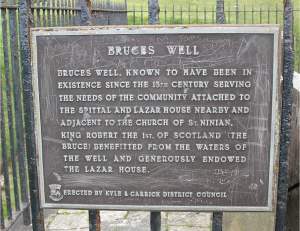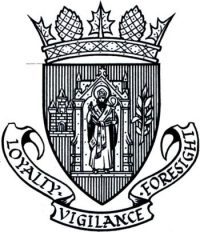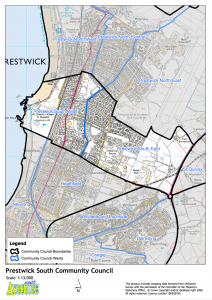Prestwick South Community Council operates in the area in Prestwick from Grangemuir Road/ Bellevue Road/Biggart Road in the north to Marchfield Road/Heathfield Road in the south and to A77 in the east.
Our area is known as the “Prestwick Toll” or “New Prestwick” since 1765 and has many interesting features and histories included in it. The area at the boundary of Ayr and Prestwick opposite the Carlton Hotel on the Ayr Road is a well maintained attractive garden which originally housed the Minister of Monkton & Prestwick the Rev.Thomas Burns. A nephew of the Poet, his distinguished ministerial career commenced in 1862 and In future years the Rev Thomas Burns emigrated to New Zealand and founded a University.
One of the “claims to fame” is the Bruces Well as Robert the Bruce visited Prestwick and rested on the site of a hospital and the walls of the old hospital are still there today.
The shopping area at the Toll is a vibrant busy part of Prestwick including a Post Office, News Agent, and many other businesses. The population of our area is approximately 6500.
The town of Prestwick can lay claim to being one of the oldest burghs in Scotland. The records show that the burgh was established in 983, although this is disputed by some historians.
That it is of ancient origin is not however in any doubt. The town grew up around the old church of St Nicholas, the ruins of which still stand amid the tumbling and decaying gravestones on the little green hill at the foot of “Kirk Street”. The ruin is said to date back to the 1100s when it was built and endowed by the High Steward of Scotland, Walter Fitz-Alan. Legend has it that there was an earlier place of worship, dating back to the early Christian arrivals.
The name Prestwick and its neighbouring village Monkton, share the same origin. Their names are derived from Priest wick – the “town (or place) of priests” and Monk- ton the town of monks. The names are said to derive from Northumbrian Anglian. With origins in 7th & 8th Century when this part of Ayrshire was held briefly by the Kingdom of Northumbria.
Like many other places throughout Scotland, the church played a major role in establishing the foundations of our communities. Prestwick is recognised as a settlement of archaeological significance but virtually the whole of the historic burgh is located within Prestwick North. ln Prestwick and the surrounding district there are still many relics and pointers to its past. lt is still little wonder that it was known as the place of priests. In the town today and in the surrounding district, the names still reflect the past- St Nicholas, St Ninians, St Cuthberts, St Quivox or the ancient name St Kevok and Ladykirk.
There is evidence that Prestwick and Monkton also had “Knights Templars”. These were monks who were trained in the use of arms, warriors who had fought in the Holy Land. A small stone in the old churchyard may mark the resting place of a “Knight of the Crusades”. The old burgh records contain a reference to the Templars – “The Temple Akir’ or lands of the Knights Templars. Today we have Templerigg Street and Templeton Crescent.
Ton looay, but formerly known as Kingcase. It was at Kingcase that Robert the Bruce endowed the Lazzar House at Bruce’s Well (the ruins of which are still visible today). Robert the Bruce had at least two reasons for being grateful to Prestwick. The men of Prestwick were quick to join his struggle for independence. ln return for their loyalty, he granted to them and their successors the “Freedoms of Prestwick” or the Lands of Prestwick. Every child in Prestwick was however brought up on the story (which may also have a large element of truth) that King Robert was hunting in the neighbourhood of Prestwick one day when he grew weary and lay down to rest. He plunged his spear into the ground and lay down in the heather. When he awoke he pulled his spear from the ground and a spring of water bubbled up. Bruce was said to be a Leper or had a skin complaint. He drank from the spring and was cured. To show his gratitude, Robert the Bruce endowed the Lazzar House, which served the town into the 1700s.
lt’s at the south end of Prestwick that we find the remnants of the old salt industry “The Salt Pans” We can also see the old coal pit and stone quarry. On the boundary with Ayr we have the Bellrock and a reminder of the Turnpike roads of the 18th and 19th century Prestwick Toll. It was in the 1960s that the Toll House was knocked down and the spot is now occupied by the Carlton Hotel.


